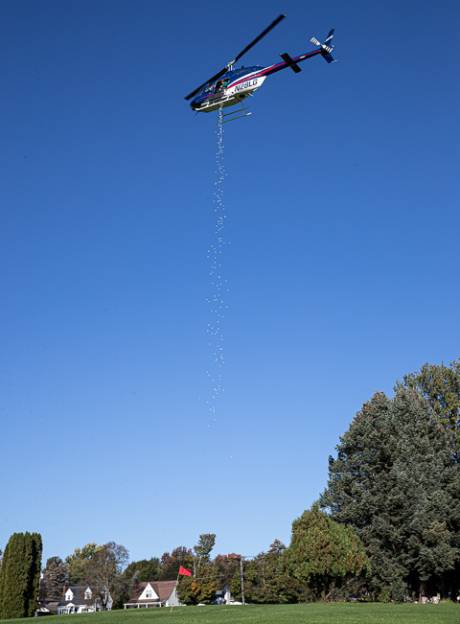Recovery of the lagoons at Batavia Waste Water Treatment Plant is heading in the right direction, according to the city’s attorney, but the end to limiting the discharge from the O-At-Ka Milk Products facility is likely several weeks away.
“We’re closely monitoring the ponds and are seeing signs of progress to determine if the BOD (Biochemical Oxygen Demand) recovery is on track,” George Van Nest said on Monday. “We’re checking it daily, twice a day, and also monitoring O-At-Ka’s loads. But the ponds are still not fully recovered at DO (Dissolved Oxygen) levels and they need to sustain (permitted levels).”
Over the past few weeks, O-At-Ka has had to pay companies to truck wastewater from its Cedar Street plant due to discovery of excessive levels of biosolids being discharged into the WWTP, costing the company around $25,0000 per day, Chief Executive Officer Bill Schreiber said.
O-At-Ka has called upon the city to sit down with company officials and the New York State Department of Environmental Conservation to find “a three-party solution” to bridge the gap until the Upstate Niagara-owned business completes a $6 million on-site pre-treatment plant project in the next six to eight weeks.
Contacted on Monday, Schreiber said he was “hopeful that we will be able to schedule a three-party meeting in the near future.”
“Our goal remains to discuss the implementation of potential solutions to accelerate the recovery of the city’s lagoons,” he said.
BOD Load Levels Are Improving
Van Nest said the city had no choice but to send a cease-and-desist letter to O-At-Ka on Sept. 23 because the BOD loads were too high.
‘We have seen significant reductions as a result of the trucking, but even with the trucking, there have been only three days below the permitted level, and closer to the level on several days,” he said.
The code gives the municipality the right to cease-and-desist, and allows the city to shut off discharges to the system completely, he said.
“The city has not done that. We’re working to get the discharge limits met and in compliance while the pond recovers.”
Van Nest said that O-At-Ka’s offer to pay any fines incurred for excessive discharge into the WWTP is not an answer to the problem.
“The ponds need to operate properly. It’s not a matter of we can indemnify you (the city) by discharging beyond the permitted level,” he said, adding that the city is responsible to its taxpayers.
“It’s taking some time to recover. We’re looking for sustainability and believe that is fairly a short-term to get to the point where engineers (working with the city) and (the WWTP) operator is comfortable with (the levels). These are 30-acre ponds, and the volumes are huge.”
'Permit Sets The Conditions'
Van Nest, when asked about a three-party solution as proposed by Schreiber and John Gould, Upstate Niagara chairman of the board, said “the solutions they are pushing for are related to the plant … and the (State Pollutant Discharge Elimination System) permit sets the conditions.”
“The city is open to meeting with O-At-Ka and its engineers,” he said. “We’re ready, willing and able to sit down with them and look at other potential solutions.”
Still, he said he doesn’t believe any of the alternatives offered by O-At-Ka will reduce the time needed for the ponds to recover to permitted DO levels.
“They mentioned cleaning the diffusers. That would be a public project that needs to be bid, let and issued, and funded. It’s a long process that would take a lot of time,” he said. “And how much of an impact would that have on the oxygen levels in the pond?”
Van Nest said sampling data showing elevated BOD and TSS (Total Suspended Solids) levels indicate that O-At-Ka increased its production capacity beyond its pre-treatment capacity.
Schreiber countered that by mentioning that the characteristics of O-At-Ka’s wastewater haven’t changed.
City Has Been Collecting Surcharges
“These are the same loads we’ve been putting down historically,” he said. “We’ve paid the city surcharges for those loads. They’re well aware of what the characteristics of what our wastewater have been and they’ve happily collected those surcharges.”
He said O-At-Ka has paid approximately $60,000 per quarter in surcharges, which are for BOD and TSS over the permitted level of 300 parts per million.
O-At-Ka’s existing pre-treatment plant is between 15 and 20 years old. In January of this year, the company’s board of directors approved a $6 million capital project to put in a new pre-treatment plant (located off Cedar Street).
“Originally, we had planned to have that up at the end of October or early November, but like everybody else, we’ve experienced a number of supply chain challenges that have pushed the date out to mid-December,” Schreiber said.
“But, again, looking to control the things we can control – such as flows down the drain – we’ve redoubled our efforts to expedite getting components here, and we think we’ll be able to get it operational between the middle of November and early December.”
Even if that’s up and running in five weeks, it would cost O-At-Ka around $875,000 to haul the wastewater to other locations.
Schreiber said O-At-Ka typically discharges around 575,000 gallons of wastewater – a milky water mixed with detergent – to the WWTP. Now, with the restrictions, that amount is 475,000 to 500,000 gallons per day.
Pre-Treatment Upgrade Underway
O-At-Ka’s current pre-treatment operation consists of two separate 150,000-gallon equalization tanks that balance pH and BOD loading, Schreiber said. The wastewater flows to the Primary Dissolved Air Flotation, which can process 360 gallons per minute, removing 25 percent of the solids.
After that, it goes to the digester, removing organic materials at 330 gallons per minute, and leaves an Immobilized Cell Bioreactor and flows through tubes that mix wastewater with chemicals to provide coagulation and flocculation. Lastly, the wastewater flows through the Secondary DAF, removing 85 to 90 percent of solids.
“The pre-treatment plant upgrades will double EQ capacity and significantly enhances the ability to remove BOD and TSS,” Schreiber said.
He said the new EQ tank is 600,000 gallons and the new moving Bed Bio Reactor can process 12,000 pounds of BOD per day. The company also has purchased three 250-horsepower blowers to make the process more efficient, and is installing an additional DAF capable of 540 gallons per minute to augment the existing unit.
Previously: O-At-Ka offers alternatives, claims city is protected as it seeks to end hauling of wastewater from its facility
































